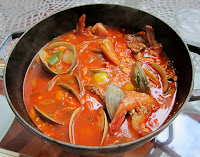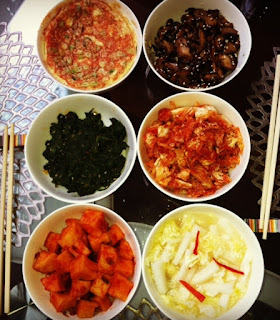We arrived in
 |
| grilled duck necks from dans les landes click here for more dans les landes photos |
Our plans for Monday evening took us to the Marais district. Before dinner, we stopped by The Experimental Cocktail Club for drinks. This was quite the experience. As someone who grew up in
After drinks, we walked a few blocks to Frenchie for dinner. The concept here is to present a nightly prix fixe menu of dishes crafted to emphasize local, seasonal foods. The menu offers two choices for each course and an optional fois opening course, so between the two of us, we sampled the full menu, as follows:
duck fois gras torchon and pear
black trompette mushrooms, chicken liver
parfait, figs, fresh hazelnuts
crab, tomato, basil, hysope
trout, cauliflower mushrooms, walnuts
guinea fowl, eggplant, bell pepper, feta
wild blackberries, lime, hazelnuts
miso ice cream, plums, raspberries
 |
| black trompette mushrooms, chicken liver parfait, figs, fresh hazelnuts from frenchie click here for more frenchie photos |
From a planner’s perspective, Tuesday’s lunch and dinner were a
mess. My idea to have a galette and cider for lunch at Little Breizh stalled when we arrived to
a sign stating that they were closed for the day so that they could paint the
restaurant. Insistent that I find
another creperie in the neighborhood,
I began an internet search that should’ve landed me at La Creperie des Canettes. As we approached rue des canettes, we saw a large yellow sign proclaiming CREPERIE
and darted right in. The server brought
us menus and while I found it odd that they were covered in pictures of clowns,
I forged ahead and ordered. Shortly thereafter,
I realized that we were not in La
Creperie des Canettes when I spotted the sign in the restaurant for Creperie du Clown. Still in the dark, I assumed that the name of
the restaurant had changed. My galette arrived, and it was okay. Not bad, not great. We finished our lunch, crossed the street,
looked back, and saw La Creperie des
Canettes right beside the clown spot.
We were oh so close.
 |
| goat cheeses from androuet click here for more androuet photos |
In keeping with Tuesday’s theme of poor planning, we walked back to the
hotel and wondered how we would ever eat dinner after such an incredible
afternoon. We lay around in a cheese
coma for a little while and finally mustered up the energy to dress for
dinner. We walked a mile to La Table d’Aki to discover that
something with our reservation was awry.
Long story short, we turned around, walked back to the hotel, and went
to bed.
 |
| le crabe royal from l'atelier de joel robuchon click here for more l'atelier de joel robuchon photos |
la
tomate
en gazpacho aux croutons dores, sorbet
moutarde a l’ancienne
le
crabe royal
aux fines lamelies de raves epicees
le
caviar
et sa crème aigre, sure une pomme de
terre mixee a l’huile d’olive des baux
l’oeuf
cocotte a la crème legere de girolles
le
foie gras
de canard chaud, cocos de paimpol au jus
d’hibiscus
le
gyoza
a la plancha, farcie de volaille, dans
son bouillon au parfum d’asie
le
saint-pierre
dore a la plancha sous une vierge
condimentee a l’huile de pistache
l’agneau
de lait
en cotelettes a la fleur de thym
le
black angus
Coeur d’onglet fondant, aux echalotes
confites
le
parfum des iles
crème aux fruits de la passion et a la
banana, granite au rhum, legerete a la noix de coco
le
chocolat tendance
ganache onctueuse au chocolat araguani,
glace au grue de cacao, biscuit oreo
We enjoyed every dish. Our
favorites included the tomato gazpacho with mustard sorbet, the crab royale, the 65-degree egg
layered between cream and mushrooms, the saint-pierre with nori and pistachio
oil, and the beef with shallot confit. Oddly enough, I expected this to be the
disappointment of the week. With so many
quaint, trendy spots on my list, I suppose I thought this wouldn’t live up to
the hype or the “big name” label. When I
mentioned to friends that we planned to lunch there, most responded with
lackluster comments seeming disappointed that we’d spend our time there. I know this much…there is a reason Robuchon’s
name is on the door. This meal was
nothing short of magnificent.
After our leisurely two-hour lunch, we ditched all plans for afternoon
museum tours and hiked around the city for the next three hours…from
Saint-Germain into the Jardin de
Tuileries down avenue des
champs-elysees to the top of the Arc
de Triomphe under the Eifel Tower through the Invalides neighborhood, and
back to our hotel in Saint-Germain. We
needed every mile of that walk.
I opted for dinner at Chez l’Ami Jean
on Wednesday night, because I wanted to experience a real neighborhood bistro
in Paris
 |
| croissant de beurre and tarte aux pommes from poilane |
 |
| pate de fruits from jacques genin chocolatier |
We spent the rest of the afternoon visiting the Pompidou Centre and leisurely walking back. As we strolled through Les Halles, I noticed
a large kitchen store on a corner and darted in. It was full of people, which seemed odd,
until I realized that it was the store made famous by Julia Child’s patronage, E. Dehillerin. For a while, I just worked through the
utensils one by one giving myself a sort of, “hmm, what does this do?”
quiz. If it hadn’t been so crowded, I
could’ve stayed for hours. Instead, we
ventured west and ducked into Telescope
for a coffee while we waited out the first rain shower of our trip.
 |
| raw oyster from spring click here for more spring photos |
buttery creamed potatoes, chervil oil
raw oysters, apple gelee, raw green apple
trout, honey-olive oil sauce, radish,
herb salad
langoustine, butternut squash puree,
chanterelles
pigeon breast, bok choy, marrow broth
pigeon leg quarters, roasted turnips,
microgreens
cheese course of chevre served on a
chestnut leaf, brie de meaux, roquefort
pear, mini mille-feuille, raspberries and
thyme
 |
| buttery potaoes and chervil oil from spring |
We slept in a little on Friday morning before visiting the Louvre for an obligatory glance at Mona Lisa and a few Michelangelo statues. Then, we lingered around the nearby gardens and just soaked in as much
crab and tofu spring roll with plum sauce
sweet potato noodles, white sesame, and
shiso
steamed oyster, fois gras, and raw
cucumber with date-seaweed sauce
steamed buns
shrimp and chanterelles in fish broth
chicken and apples with shaoxing wine
sauce
chocolate cake with almond cream and
brittle
raspberry sorbet and fresh raspberries
 |
| shrimp and chanterelles in fish broth from yam'Tcha click here for more yam'Tcha photos |
We spent the rest of the afternoon strolling through St. Germain. After a leisurely visit to Delacroix’s home,
we headed to Pierre Herme for a
sampler box of macarons. (Earlier in the
week, we sampled macarons from Laduree
and Sadaharu Aoki, and I needed to
try Pierre Herme before we left the
city in order to form a somewhat knowledgeable opinion in the whole “best
macaron in Paris
Friday evening, we headed north on the metro for dinner at Le Chateaubriand. Until this point, our Paris Paris
cheese puffs
ceviche shots
fried shrimp with passionfruit powder
squid noodles, squid ink, raw pear
raspberry lobster broth
red snapper, green tomato, pimenton
bream, mushrooms, yellow beans, fermented
black beans
rare beef with thin potato crisps and
chives
egg yolk atop crunchy meringue
chocolate ganache, fresh mint granite,
cocoa powder
fresh strawberries and candied anise seed
As the menu progressed, my admiration for everything Le Chateaubriand amplified. We reached the pinnacle of the meal when a
server presented the egg yolk atop crunchy meringue. He instructed us to eat the whole yolk and
meringue in one bite, so I carefully scooped the full bite into my spoon. Wow!
The yolk oozed into the meringues, and as the crunchy bits of meringue
began to melt, the textures and flavors achieved a beautiful synergy. Without question, that was the best bite of
our vacation. The server smiled and
nodded. Later, he told us that it is his
favorite dish, as well, and the three of us spent a few minutes discussing and honoring
every perfect detail of it. This is the
kind of energy I love in a restaurant. From
the bussers to the kitchen, everyone working there believed in, embraced, and
supported the cause wholeheartedly. Fresh
and hip. Bold and creative. Emotive and smart. Dinner at Le
Chateaubriand transformed and elevated my idea of a great meal, and its
spirit will forever dwell within me.
Best meal of the vacation!
 |
| egg yolk atop crunchy meringue from le chateaubriand click here for more le chateaubriand photos |
Our week in Paris Miami









